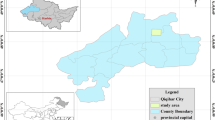Abstract
Windspeed reduction in shelter is generally expressed relatively and is usually assumed to be independent of open windspeed. The purpose of this study was to re-examine the relationship between open windspeed and windspeed reduction in shelter using windspeeds and wind directions measured for two windbreak systems at various distances from the windbreaks and with three windbreak porosities. Optical windbreak porosities were estimated from digitized color photographs using an intelligent (trainable) image processing program. Relative windspeed reduction in shelter was found to be related to the open windspeed. There existed a threshold windspeed at approximately 5 m s−1, below which relative windspeed reduction varied but generally decreased as the open windspeed increased. Above the threshold windspeed, open windspeed did not have an effect on relative windspeed reduction in the sheltered zone. Using the threshold windspeed reduction, the authors propose an index to evaluate the effectiveness of a windbreak for the overal windspeed protection.
Similar content being viewed by others
References
Aono M and Kunii TL (1984) Botanical tree image generation. IEEE Computer Graphics and Appl 5: 10–34
Baer NW (1989) Shelterbelt and windbreaks in the Great Plains. J For 87(4): 32–36
Borrelli J, Gregory JM and Abtew W (1989) Wind barriers: a reevaluation of height, spacing, and porosity. Trans ASAE 32: 2023–2027
Brandle JR, Hintz DL and Sturrock JW (eds) (1988) Windbreak Technology, Elsevier Science Publishers, Amsterdam, 598 pp
Brown KW and Rosenberg NJ (1971, 1972) Shelter-effects on microclimate, growth and water use by irrigated sugar beets in the Great Plains. Agric Meteorol 9: 241–263
Caborn JM (1957) Shelterbelts and Microclimate. For Comm Bull No 29, Edingurg, 135 pp
Cao X (1985) Field Windbreaks, China Forestry Publishing House, Beijing, 645 pp
Draper N and Smith H (1981) Applied Regression Analysis, John Wiley and Sons, New York, 709 pp
Heisler GM and DeWalle DR (1988) Effects of windbreak structure on wind flow. Agric Ecosyst Environ 22/23: 41–69
Hagen LJ, Skidmore EL, Miller PL and Kipp JE (1981) Simulation of effect of wind barriers on airflow. Trans ASAE 24: 1002–1008
Jensen M (1961) Shelter effect: Investigation into the Aerodynamics of Shelter and its Effects on Climate and Crops. Danish Technical Press, Copenhagen, 263 pp
Kenny WA (1987) A method for estimating windbreak porosity using digitized photographic silhouettes. Agric For Meteorol 39: 91–94
Konstantinov AR and Struzer LR (1969) Shelterbelts and Crop Yields. US Office of Technical Services, Washington, DC, TT68-50370. Translated by Israel Program for Sci Translations Ltd
Loeffler AE (1990) Using optical porosity to evaluate the shelter effectiveness of windbreaks in southern Ontario. Master's Thesis, University of Guelph, Guelph, Ontario, Canada
Loeffler AE, Gordon AM and Gillespie TJ (1992) Optical porosity and windspeed reduction by coniferous windbreaks in southern Ontario. Agrofor Syst 17: 119–133
mcNaughton KG (1988) Effects of windbreaks on turbulent transport and microclimate. Agric Ecosyst Environ 22/23: 17–39
McNaughton KG (1989) Micrometeorology of shelter belts and forest edges. Phil Trans R Soc London B 324: 351–368
Miller DR, Rosenberg NJ and Bagley WT (1975) Wind reduction by a highly permeable tree shelterbelt. Agric Meteorol 14: 321–333
Morse DR, Lawton JH, Dodson MM and Williamson MH (1985) Fractal dimension of the vegetation and the distribution of arthropod body lengths. Nature 314: 731–733
Nägeli WV (1965) Über die Windverhaltnisse im Bereich gestaffelter Windschutzstreifen. Mitt Schweiz Anstalt 41: 221–300
Ogawa Y and Diosey PG (1980) Surface roughness and thermal stratification effects on the flow behind a two-dimensional fence-I. field study. Atmos Environ 14: 1301–1308
Plate EJ (1971) The aerodynamics of shelter belts. Agric Meteorol 8: 203–222
Price TV and Osborne CF (1990) Computer imaging and its application to some problems in agriculture and plant science. Critical Rev Plant Sci 9: 235–266
Raine JK and Stevenson DC (1977) Wind protection by model fences in a simulated atmospheric boundary layer. J Int Aero 2: 159–180
Rosenberg NJ, Blad BL and Verma SB (1983) Microclimate: The Biological Environment. John Wiley and Sons, New York 495 pp
Seginer I (1972) Windbreak drag calculated from the horizontal velocity field. Boundary-Layer Meteorol 3: 87–97
Seginer I (1975) Atmospheric-stability effect on windbreak shelter and drag. Boundary-Layer Meteorol 8: 383–400
Seginer I and Sagi R (1971, 1972) Drag on a windbreak in two-dimensional flow. Agric Meteorol 9: 323–333
Song Z, Meng P, Zhang H, Lu G, Zhou H, Hong S, Liu Y and Zhang T (1987) A study on the effect of windbreaks on meteorological factors and wheat yield in Heilonggang reaches. In: Song Z (ed) A Collection of Papers on Forest Meteorology in China, pp 122–129. Meteorology Publishing House, Beijing
Sturrock JW (1969) Aerodynamic studies of shelterbelts in New Zealand-1 low to medium height shelterbelts in mid-Canterbury. New Zealand J Sci 12: 754–776
van Eimern J, Karschon R, Razumova LA and Robertson GW (1964) Windbreaks and shelterbelts. WMO Tech Note No 59, 188 pp
Vlcek J and Cheung E (1986) Fractal analysis of leaf shapes. Can J For Res 16: 124–127
Wei L, Jiang A and Zhang Y (1987) On the effective protecting distance of shelterbelts. Kexue Tongbao (Sciences Reports) 32: 605–609
Wen K-J and Wang Y-S (1991) The statistical analysis of shelterbelt structure and windproof efficiency. Agric For Meteorol 53: 257–266
Wong D (1981) Microclimate and Crop Microclimate. China Agriculture Publishing House, Beijing, 160 pp
Zeide B and Pfeifer P (1991) A method for estimation of fractal dimension of tree crowns. For Sci 37: 1253–1265
Zhang H, Brandle JR, Meyer GE and Hodges L (1995) A model to evaluate windbreak protection efficiency. Agroforestry Systems 29: 191–200
Zhao Z, Xiao L, Zhao T and Zhang H (1995) Windbreaks for Agriculture. China Forestry Publishing House, Beijing, 400 pp
Author information
Authors and Affiliations
Additional information
Published as Journal Series No. 10815 of the Agricultural Research Division, University of Nebraska.
Rights and permissions
About this article
Cite this article
Zhang, H., Brandle, J.R., Meyer, G.E. et al. The relationship between open windspeed and windspeed reduction in shelter. Agroforest Syst 32, 297–311 (1995). https://doi.org/10.1007/BF00711717
Issue Date:
DOI: https://doi.org/10.1007/BF00711717




